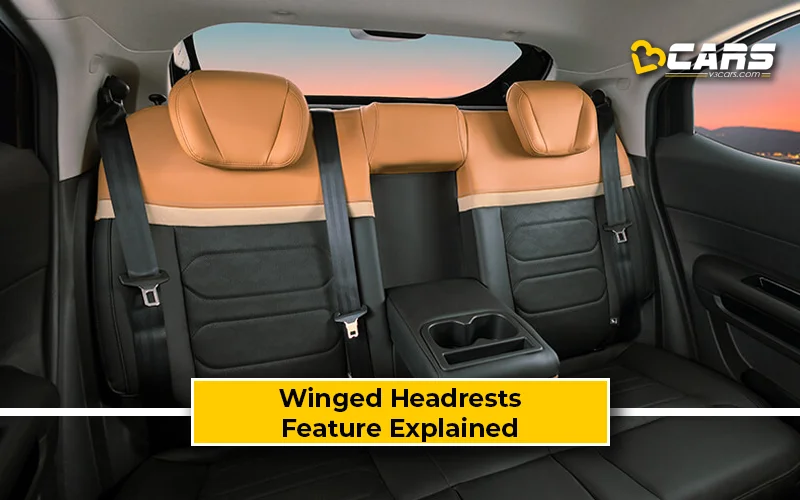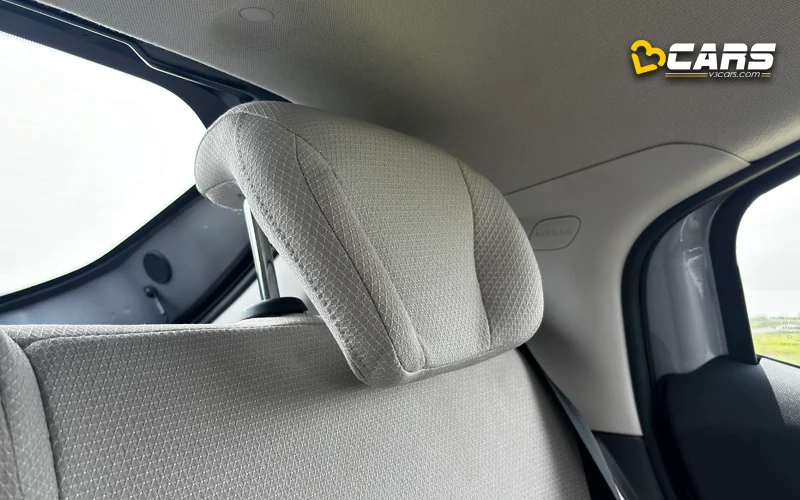Winged Headrests – Feature Explained
Car manufacturers in India have been steadily adding comfort-oriented features that were once reserved for luxury sedans and SUVs into their mass-market offerings. One such feature that has made its way into more mainstream models is winged headrests. While not as flashy as panoramic sunroofs or ADAS, this small but thoughtful addition can make a big difference to rear-seat comfort, especially on long drives.

In this feature explained article, we break down exactly what winged headrests are, how they work and whether they’re worth choosing on your next car.
What Are Winged Headrests?
Winged headrests are specialised headrests with foldable “wings” or side bolsters that can be adjusted outward. When opened, these wings support the passenger’s head from the sides, reducing neck strain during long journeys or while resting.
Think of them like winged headrests found in business class aircraft seats that are designed to keep your head from flopping sideways when you doze off.
In India, the feature is still emerging but slowly gaining traction as rear-seat comfort becomes a higher priority for buyers.
How Do Winged Headrests Work?
TWinged headrests use a mechanical hinge mechanism inside the side bolsters. You can adjust the wings simply by:
- Pulling them outward until they click into position
- Setting the angle that supports your head or neck
- Pressing them back in when not needed
Winged headrests do not use any electronics or motors. They use a simple but effective design that enhances comfort without adding complexity. The simplicity also ensures they are long-lasting and easy to maintain.
What Are The Pros And Cons Of Winged Headrests?
Here are the pros, or advantages, of winged headrests:
- Better comfort from rear passengers: They prevent your head from tilting awkwardly on long drives. Especially useful for elderly passengers and people who prefer to nap during long drives.
- Reduces neck and shoulder fatigue: The wings provide lateral support, which helps keep your posture aligned and reduces strain, particularly on highways.
- Improves perceived cabin luxury: Winged headrests add a premium feel to the cabin, similar to the experience in luxury cars and business-class flights.
- No power components, low chance of failure: The simple mechanical design makes them reliable and fuss-free.
Here are the cons, or disadvantages, of winged headrests:
- Now very useful with 3 passengers: The middle occupant may find the outer headrests intrusive if the wings are extended.
- Restricted rear visibility when extended: When both wings are open, they can slightly obstruct the driver’s view through the inside rearview mirror (IRVM).
- Limited availability in mass-market cars: Only a handful of mass-market cars currently offer this feature.
Can Winged Headrests Be Fitted From The Aftermarket?
Technically, yes. Aftermarket winged headrest cushions exist. However, they are usually strap-on pillows, not actual winged headrests. These strap-on pillows do not offer the same structural support as winged headrests. Additionally, they can interfere with whiplash safety if poorly designed. OEM options are rarely available unless the car originally offered them in higher variants.
For safety and fitment reasons, we do not recommend replacing the fixed OEM headrests with aftermarket adjustable ones unless you are installing official accessories designed for your specific model.
How Expensive Is It To Repair Or Replace Winged Headrests?
Since there are no electronics or motors, repair costs are typically low.
- Mechanical hinge replacement: Rs. 800 - Rs. 2,000
- Complete headrest replacement (OEM): Rs. 2,500 - Rs. 8,000 (depending on brand and model)
- Premium SUVs and EVs: Can go up to Rs. 15,000 - Rs. 20,000
If only the wing mechanism breaks, manufacturers often allow replacing just the hinge assembly rather than the entire headrests, thus reducing repair costs.
Affordable Cars In India That Offer Winged Headrests
While still a niche feature, a few models offer winged headrests in higher variants:
- Citroen Basalt X and Aircross X
- Tata Harrier and Safari
- Hyundai Alcazar (6-seater)
Availability varies by variant and model year. However, the trend shows that more C- and D-segment SUVs and MPVs will add this feature in the near future as more families start prioritising rear-seat comfort.
Also Read: Power-Adjustable Driver Seat - Detailed Feature Explained
Helpful Tools:
- Fuel Cost Calculator for Cars – Know your monthly fuel expense based on usage and mileage
- Car On-Road Price Calculator – Convert ex-showroom to on-road price for any city
Sell Used Car Online – Enter your car and contact details to get an instant price estimate and book a free inspection with our partner network



0 Comments